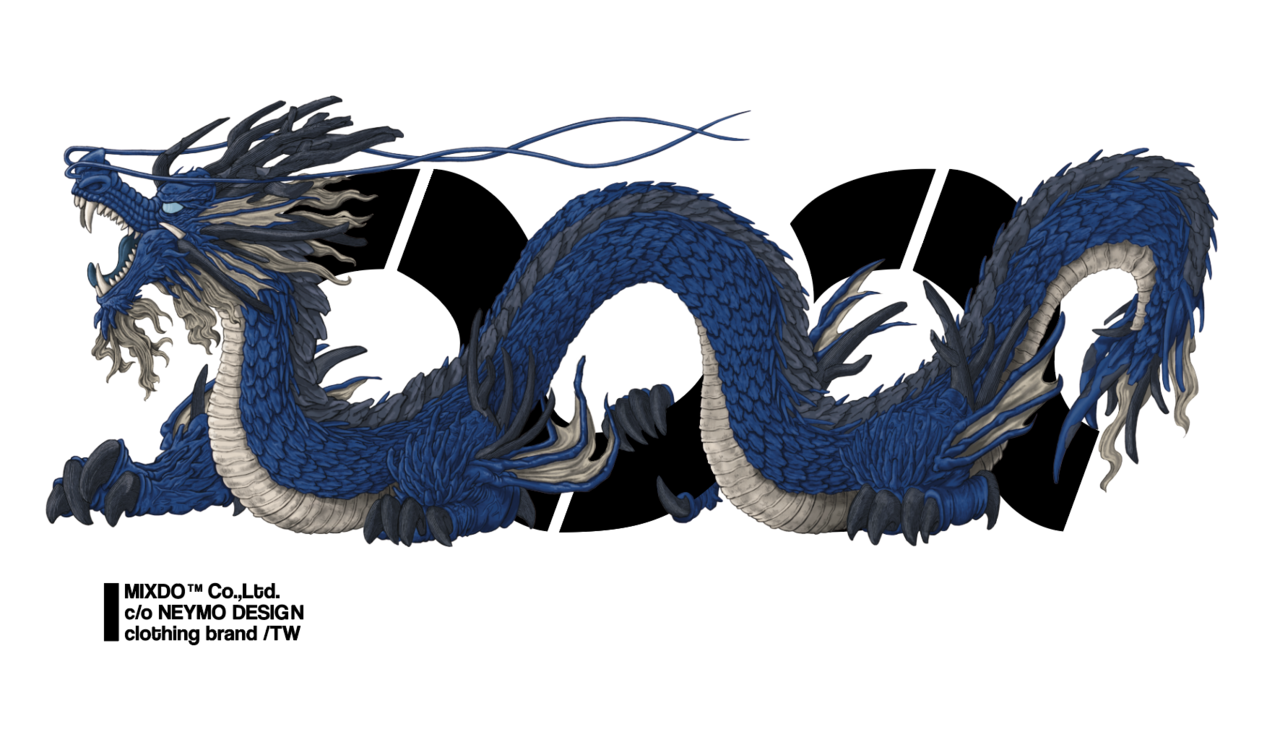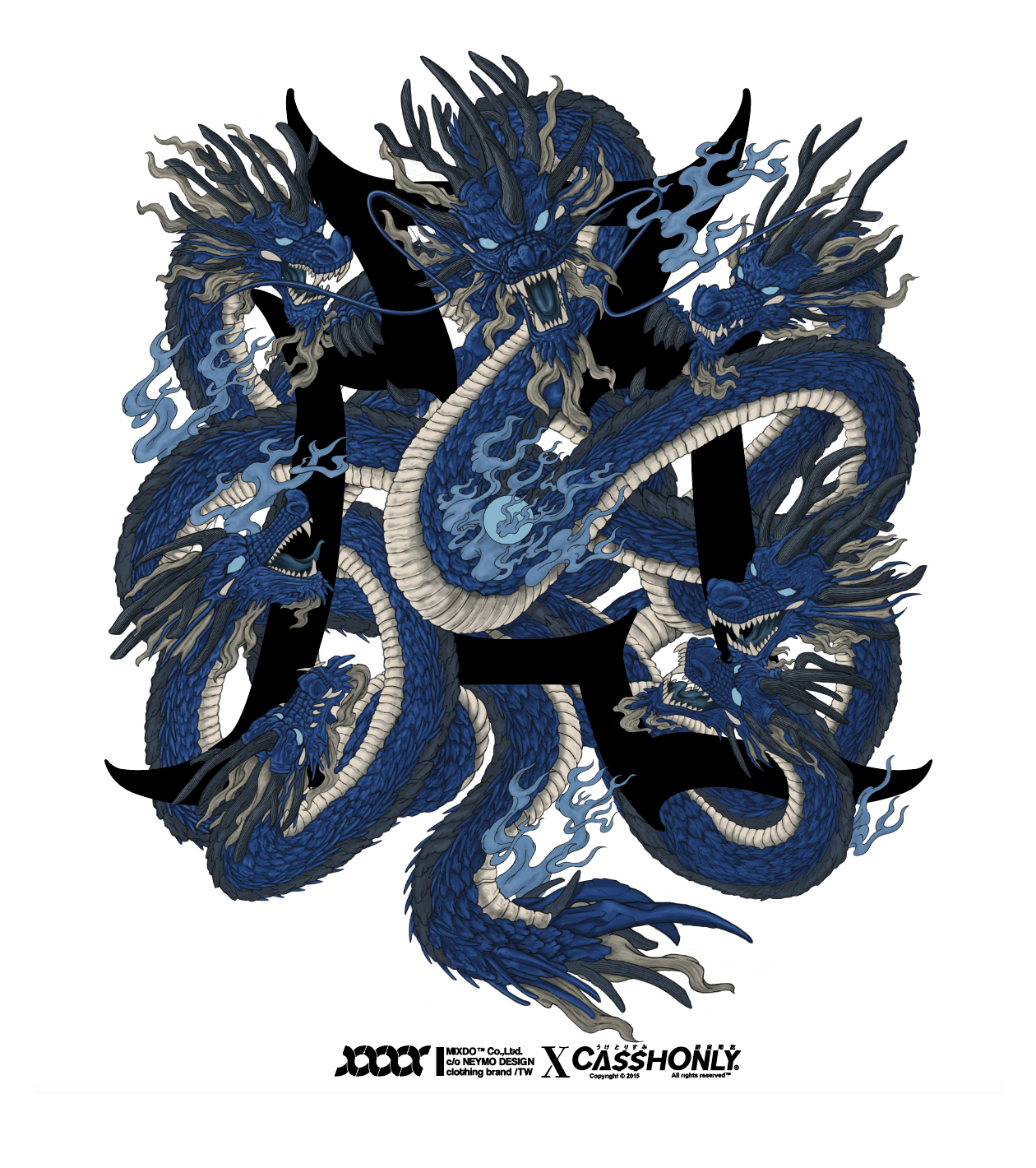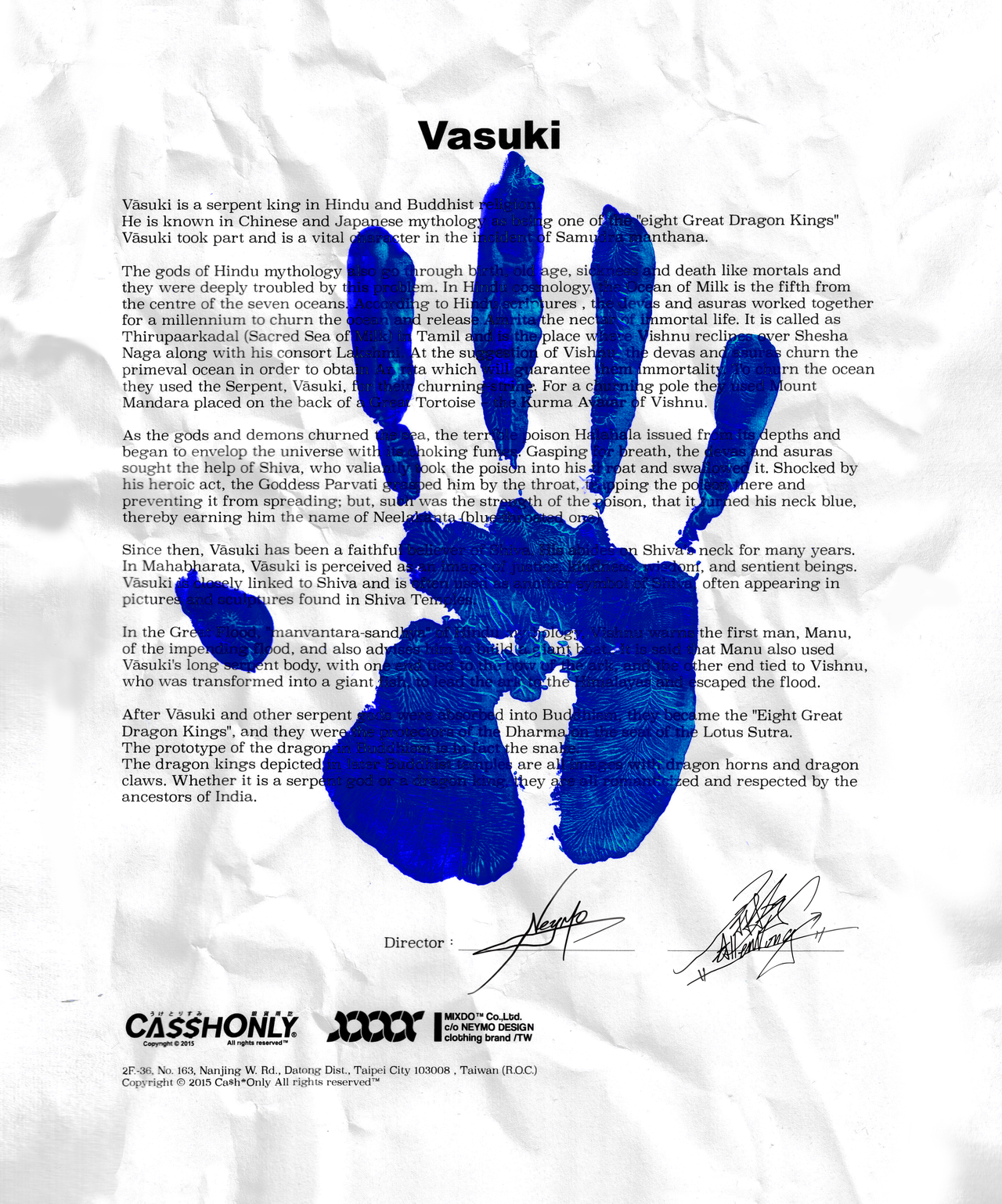
21 Fall/Winter-Cashonly x Mixdo -Vasuki
婆蘇吉(वासुकि),是印度神話中的蛇神,也是佛教八大龍王之一,是眾多蛇神的大領袖。在創世神話「乳海攪拌」事件中,婆蘇吉也擔當重要的角色。

印度神話的眾神也如同凡人一般有著生老病死,眾神一直被這個問題所困擾。眾神所居住的世界中心、最高山須彌山四周被宇宙海乳海所包圍,據說在這片乳海中蘊藏著長生不老的甘露,以濕婆為首的眾神與阿修羅族為了獲得甘露,在經過長久的爭鬥之後協議要一起合作。祂們以婆蘇吉如山脈一般巨大的身軀為絞繩,一端由92個阿修羅在岸邊握著,另一端由88個天神在對岸抓著,蛇身中間則纏繞著曼陀羅山,以曼陀羅山(須彌山)為攪棒向乳海作出激烈的攪拌,希望取得乳海底的甘露。
在持續攪拌了一千年後,龍王婆蘇吉終於受不住翻攪過程的劇痛,從口中吐出劇毒,這口恐怖的毒液可以毀滅三界,在危急的關頭濕婆挺身而出,將毒液一口吞下拯救了世界與眾生,而濕婆的妻子雪山女神為了保護濕婆不讓毒液流進腹中傷害濕婆,便出手扼住濕婆的喉嚨,但濕婆的喉嚨也因此被毒液灼成了青紫色,因此濕婆又被稱為青喉者(Nīlakaṇṭha)。
自此婆蘇吉便成為濕婆的忠實信徒,祂長年盤據在濕婆的脖子上,在《摩訶婆羅多》中,婆蘇吉被描述為正義、仁慈、智慧、心懷眾生的形象,祂更是與濕婆緊緊聯繫起來,常作為濕婆的另一種象徵,經常出現在濕婆神廟中的圖畫與雕塑中。
印度神話中的滅世洪水事件中,人類始祖摩奴在化身為魚的毗濕奴提示下,製造拯救萬物生靈的大方舟。據說摩奴當時亦以婆蘇吉的長蛇軀體,一端繫緊方舟的船頭,另一端繫在化身為巨魚的毗濕奴身上,讓巨魚牽著方舟到達喜馬拉雅山逃過洪水之劫。
婆蘇吉等蛇神後被吸納進佛教中,就成了「八大龍王」,是列於法華經會座上的護法善神。佛教中的龍原型其實就是蛇,在傳入中國後與神話傳說中的「龍」融合統一,
後世的佛寺中描繪的龍王都是有龍角、龍爪之形象,無論是蛇神抑或是龍王,都是時代的巨輪裡,先民對於自然力量與巨大生物的敬畏與浪漫。
Vāsuki is a serpent king in Hindu and Buddhist religion. He is known in Chinese and Japanese mythology as being one of the "eight Great Dragon Kings" Vāsuki took part and is a vital character in the incident of Samudra manthana.
The gods of Hindu mythology also go through birth, old age, sickness and death like mortals and they were deeply troubled by this problem. In Hindu cosmology, the Ocean of Milk is the fifth from the centre of the seven oceans. According to Hindu scriptures , the devas and asuras worked together for a millennium to churn the ocean and release Amrita the nectar of immortal life. It is called as Thirupaarkadal (Sacred Sea of Milk) in Tamil and is the place where Vishnu reclines over Shesha Naga along with his consort Lakshmi. At the suggestion of Vishnu, the devas and asuras churn the primeval ocean in order to obtain Amrita which will guarantee them immortality. To churn the ocean they used the Serpent, Vāsuki, for their churning-string. For a churning pole they used Mount Mandara placed on the back of a Great Tortoise – the Kurma Avatar of Vishnu.
As the gods and demons churned the sea, the terrible poison Halahala issued from its depths and began to envelop the universe with its choking fumes. Gasping for breath, the devas and asuras sought the help of Shiva, who valiantly took the poison into his throat and swallowed it. Shocked by his heroic act, the Goddess Parvati grasped him by the throat, trapping the poison there and preventing it from spreading; but, such was the strength of the poison, that it turned his neck blue, thereby earning him the name of Neelakanta (blue-throated one).
Since then, Vāsuki has been a faithful believer of Shiva and abides on Shiva’s neck for many years. In Mahabharata, Vāsuki is perceived as an image of justice, kindness, wisdom, and sentient beings. Vāsuki is closely linked to Shiva and is often used as another symbol of Shiva, often appearing in pictures and sculptures found in Shiva Temples.
In the Great Flood, "manvantara-sandhya" of Hindu mythology, Vishnu warns the first man, Manu, of the impending flood, and also advises him to build a giant boat.. It is said that Manu also used Vāsuki's long serpent body, with one end tied to the bow of the ark, and the other end tied to Vishnu, who was transformed into a giant fish, to lead the ark to the Himalayas and escaped the flood.
After Vāsuki and other serpent gods were absorbed into Buddhism, they became the "Eight Great Dragon Kings", and they were the protectors of the Dharma on the seat of the Lotus Sutra. The prototype of the dragon in Buddhism is in fact the snake.
The dragon kings depicted in later Buddhist temples are all images with dragon horns and dragon claws. Whether it is a serpent god or a dragon king, they are all romanticized and respected by the ancestors of India.
